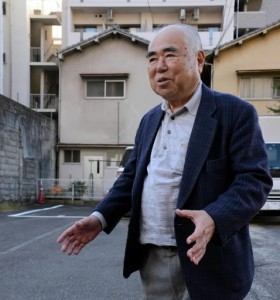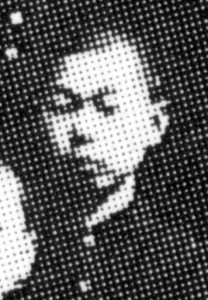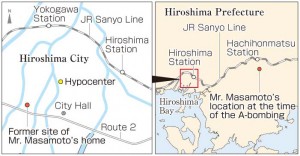Yoshitada Masamoto, 82, Nishi Ward, Hiroshima
Nov. 26, 2014
Father’s remains identified through embroidery: Kindness received in ruins will never be forgotten
by Takayuki Kamo, Staff Writer
When he was 12 years old, Yoshitada Masamoto, 82, lost his father and his home to the atomic bombing. With no income, savings or food, his mother and her three junior high school-age boys struggled to survive. Nothing sustained them more than the kindness they received from the people around them. “I survived because of the kindness of many people,” Mr. Masamoto said. “I’ll never forget how indebted I am to them.”
At the time of the A-bombing Mr. Masamoto was a first-year student at the junior high school affiliated with the Hiroshima Higher Normal School (now the junior high school affiliated with Hiroshima University). He was to have worked on the demolition of buildings for fire breaks in the city, but thanks to the concern of a teacher who believed it was dangerous to stay in Hiroshima, he relocated to Hara-machi in Kamo-gun (now part of the city of Higashi Hiroshima), where he was a member of the Agricultural Volunteer Corps.
On the morning of August 6, 1945, he was walking along a path between rice fields when he spotted a B-29 in the skies over Hiroshima. Before long a bright light flashed before his eyes and a warm breeze brushed his cheeks, although he was about 20 km away. Just after that the air shook with the sound of the blast, and the mushroom cloud rose beyond the hills.
Later that day he learned that Hiroshima was in a shambles and that his mother was safe but his father was missing. He arrived in Hiroshima on August 18. He and a classmate walked from Hiroshima Station amid the skeletons of destroyed buildings and the smell of charred ruins. Water spewed from ruptured pipes. Funairi Nakamachi (now part of Naka Ward), where his home was located, was completely burned out.
Mr. Masamoto’s father’s remains were found in June 1946. The charred remains of six or seven bodies were found under bricks at the ruins of an ice company his father had done business with in Tsukamoto-cho (now Dobashi-cho in Naka Ward). Among them was a femur around which was a legging with “Masamoto” written on it. The name had been embroidered on the legging by Mr. Masamoto’s mother. At that time Mr. Masamoto vowed to be strong and never cause his mother to worry.
At the time of the atomic bombing his mother was at Hiroshima Station. She was uninjured. His eldest brother, a member of the Tsuiki Air Corps in Oita Prefecture, and his second eldest brother, a student who had been mobilized to work on Miyajima, returned home and their new life began. They put up a shack on the site of their home using wood that they gathered from the ruins.
A tradesman who had been a member of the neighborhood community association cleaned off the tiles they scrounged up. At Mr. Masumoto’s suggestion, the family opened a shaved ice shop. A carpenter they knew erected the building for them. A family housed the Masamotos for a while before they constructed their own home. Many of those who helped the family said they did so out of gratitude for things Mr. Masamoto’s father had done for them in the past. Whenever he heard that, Mr. Masamoto recalled his hard-working father, who was always willing to help others.
Mr. Masamoto engaged in volunteer activities while running a landscape gardening business. He was impressed by the actions of Takashi Nagai, the physician who treated the injuries of survivors despite being injured himself in the A-bombing of Nagasaki. Mr. Masamoto cares for a rose that was sent to Hiroshima by Dr. Nagai and planted on Peace Boulevard in Naka Ward. Thinking back, he feels he does it out of a sense of indebtedness for the many acts of kindness he received amid the ruins of Hiroshima.
Although he was exposed to radiation upon entering the city, Mr. Masamoto is healthy and happy. “I don’t want young people to suffer as I did, so I have to tell the next generation about my experiences,” he said. Whenever he sees the petals of roses or cherry blossoms, he recalls the bright red of an oleander that bloomed amid the burned-out ruins and the solace and hope it gave him in those days.
Teenagers’ impressions
Gratitude for peace and good health
Mr. Masamoto said that in order to end war, nations must stop their self-seeking behavior and their citizens must share that desire. I agree. Mr. Masamoto said he tells people at his company to cherish peace, good health and their families and be grateful for them. I’d like to maintain an interest in these things, which I’ve taken for granted, in everyday life. (Terumi Okada, second-year junior high school student)
Sense of bomb’s terrible power
Mr. Masamoto, who was in Higashi Hiroshima at the time of the atomic bombing, said he learned that afternoon that something terrible had happened in Hiroshima. I was surprised at how fast news traveled amid the destruction. When I heard that a warm breeze from the blast traveled such a long distance I sensed the bomb’s terrible power and felt I’d gained a broader perspective. (Ishin Nakahara, first-year high school student)
Surprise upon traveling same route
I traveled by car the route that Mr. Masamoto took when he first walked to his house from Hiroshima Station. It’s quite a long way even by car, so I was amazed that he walked it amid the heat and strange smells. He said he didn’t want young people to experience what he and other survivors had experienced. I’d like to think about what I must do so that I will never experience war or an atomic bombing. (Maiko Hanaoka, first-year high school student)
(Originally published on November 17, 2014)










